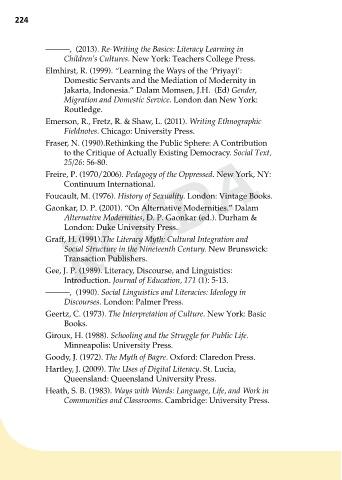Page 238 - LITERASI-BUKU-SEBAGAI-SARANA-MENUMBUHKAN-KEPRIBADIAN-PESERTA-DIDIK-YANG-UNGGUL
P. 238
224
———, (2013). Re-Writing the Basics: Literacy Learning in
Children’s Cultures. New York: Teachers College Press.
Elmhirst, R. (1999). “Learning the Ways of the ‘Priyayi’:
Domestic Servants and the Mediation of Modernity in
Jakarta, Indonesia.” Dalam Momsen, J.H. (Ed) Gender,
Migration and Domestic Service. London dan New York:
Routledge.
Emerson, R., Fretz, R. & Shaw, L. (2011). Writing Ethnographic
Fieldnotes. Chicago: University Press.
Fraser, N. (1990).Rethinking the Public Sphere: A Contribution
ROSDA
to the Critique of Actually Existing Democracy. Social Text,
25/26: 56-80.
Freire, P. (1970/2006). Pedagogy of the Oppressed. New York, NY:
Continuum International.
Foucault, M. (1976). History of Sexuality. London: Vintage Books.
Gaonkar, D. P. (2001). “On Alternative Modernities.” Dalam
Alternative Modernities, D. P. Gaonkar (ed.). Durham &
London: Duke University Press.
Graff, H. (1991).The Literacy Myth: Cultural Integration and
Social Structure in the Nineteenth Century. New Brunswick:
Transaction Publishers.
Gee, J. P. (1989). Literacy, Discourse, and Linguistics:
Introduction. Journal of Education, 171 (1): 5-13.
———, (1990). Social Linguistics and Literacies: Ideology in
Discourses. London: Palmer Press.
Geertz, C. (1973). The Interpretation of Culture. New York: Basic
Books.
Giroux, H. (1988). Schooling and the Struggle for Public Life.
Minneapolis: University Press.
Goody, J. (1972). The Myth of Bagre. Oxford: Claredon Press.
Hartley, J. (2009). The Uses of Digital Literacy. St. Lucia,
Queensland: Queensland University Press.
Heath, S. B. (1983). Ways with Words: Language, Life, and Work in
Communities and Classrooms. Cambridge: University Press.

